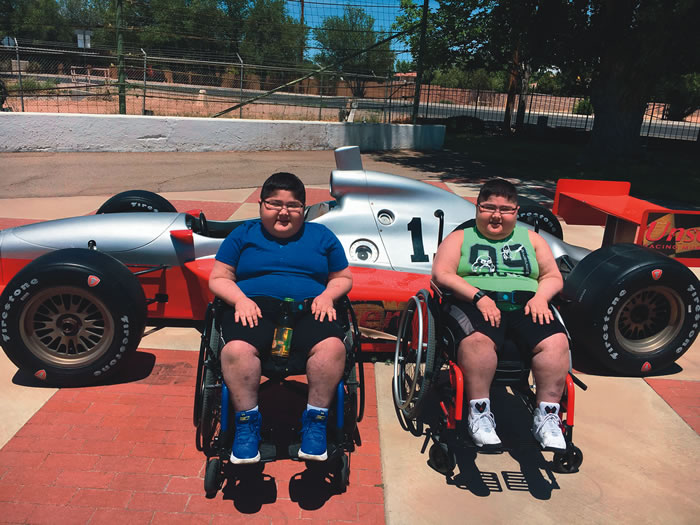
Learning to Love Your Wheels

Tips for transitioning from walking to using a mobility device
Matt Curcio is a 27-year-old disability rights advocate who is living with a form of congenital myopathy. He regularly speaks and writes to increase awareness of the disability community’s needs and encourage individuals with disabilities to seek the support they need to pursue their dreams.
Yet, even as he advocates for others, he has experienced his own struggles with asking for assistance. “Even at a young age, I’ve considered certain types of help as enablement for myself,” he says. As his disease progressed, he resisted using a mobility device for as long as possible. While Curcio can still walk short distances, he now relies on a mobility scooter outside his apartment. Transitioning to the scooter was a 12-year process.
“It happened against my will,” he says. “As an advocate, I’m all about people using medical devices to be more independent. As an individual, it has been a very contentious transition.”
From the outside, using mobility equipment when you can no longer be independently mobile seems simple. However, when you or your child is the one facing the transition, it’s not so easy. Worries about how you will be seen by others, anxiety about the rate of disease progression and fear of the unknown are common.
While there is no one-size-fits-all approach to embracing mobility equipment, individuals who have made the transition, and the caregivers and care providers who help them through it, offer some valuable advice.
1. Take time to grieve
Jenny Kean, LCSW, a social worker who works with children with neuromuscular diagnoses at the Ann & Robert H. Lurie Children’s Hospital of Chicago, encourages parents and caregivers to give their kids — and themselves — the space to be upset and grieve. “The loss of ambulation is an emotional loss,” she says. “It’s healthy to grieve and cry about it.”
Keeping the lines of communication open can help family members successfully navigate the grieving process.
“The unknown piece is very scary,” she says. “Helping kids talk openly about their muscles and how they are changing in language that makes sense to them can be very powerful. It helps prepare them for what is to come.”
2. Keep kids involved
For years, doctors advised Shannon Mosimann to put her 13-year-old twin sons Race and Ried in wheelchairs. Rather than forcing wheelchairs on her sons, who are both living with Duchenne muscular dystrophy (DMD), she asked them if they wanted to continue walking.
“I let most of these decisions come from them,” she says. “If they said they wanted to keep on walking, I supported them.”
Ann Motl, a 27-year-old litigation attorney with Charcot-Marie-Tooth disease (CMT), says she would have liked to have been offered the same choice. When she was in middle school, she was told that she had to use a mobility scooter during recess.
“I didn’t feel like I needed it at the time,” she recalls. “I wish I would have been the one to make that decision.”
3. Know your options
Motl says it can been helpful to keep in mind that transitioning to a powered mobility device does not always close the door on walking. “Some people can still do a combination of typical walking, walking with a mobility aid, and powered mobility,” she says. “Check out your options. It was easy for me to start with a scooter and then transition to a customized wheelchair as things got more difficult.” (Learn how to choose a power mobility aid in “Get Ready to Roll.”)
Race and Ried currently have enough arm strength to propel their wheelchairs, so they are using power-assisted manual wheelchairs.
“There’s a motor on the back equipped with a switch,” Ried says. “It can help when we’re going uphill, or if we’re tired and can’t wheel ourselves, we can turn it on so all we need to do is steer.”
4. Change your perspective
Some might view the transition to a mobility aid as losing freedom, but clinging to that perspective is limiting. The transition can be life-changing in a positive way. It can allow an individual to maintain independence, reduce risk of injury and continue living life to
the fullest.
Wheelchair use has given Race and Ried more freedom. “Before they got their wheelchairs, they couldn’t go to the mall, they couldn’t go to the zoo and they couldn’t go to the store,” Mosimann says. “Getting the chairs has really extended their mobility and increased their independence.”
Once Race felt his newfound freedom, he gained a new perspective. “The most important things are on the inside,” he says. “Focus on the lungs and heart, because you could live without your legs, but you can’t live without those organs.”
Karen Henry is a freelance writer and editor living with limb-girdle muscular dystrophy (LGMD) in the Denver area.
MDA Resource Center: We’re Here For You
Our trained specialists are here to provide one-on-one support for every part of your journey. Send a message below or call us at 1-833-ASK-MDA1 (1-833-275-6321). If you live outside the U.S., we may be able to connect you to muscular dystrophy groups in your area, but MDA programs are only available in the U.S.
Request Information